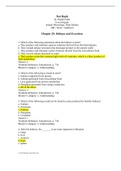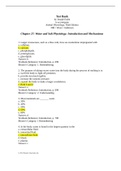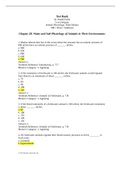SCIENCE 207 (exam)
The City College Of New York
Page 2 out of 18 results
Sort by
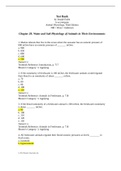
-
Chapter 28: Water and Salt Physiology of Animals in Their Environments Hill • Wyse • Anderson
- Exam (elaborations) • 20 pages • 2022
-
- $9.49
- + learn more
1. Marine teleosts that live in the ocean where the seawater has an osmotic pressure of 800 mOsm have an osmotic pressure of _______ mOsm. a. 900 b. 850 c. 800 d. 600 e. 500 Answer: e Textbook Reference: Introduction, p. 717 Bloom’s Category: 3. Applying 2. If the osmolarity of freshwater is 100 mOsm, the freshwater animals would regulate their blood to an osmolarity of about _______ mOsm. a. 70 b. 80 c. 90 d. 100 e. 120 Answer: e Textbook Reference: Animals in Freshwater, p....

-
AnPhys3e Ch13 Test Bank Chapter 13: Synapses
- Exam (elaborations) • 23 pages • 2022
-
- $9.49
- + learn more
Chapter 13: Synapses 1. A specialized site of contact of one neuron with another neuron (or effector) is known as a a. neuron. b. receptor–neurotransmitter complex. c. muscle. d. membrane. e. synapse. Answer: e Textbook Reference: Introduction, p. 327 Bloom’s Category: 1. Remembering 2. Which of the following transmits information the fastest? a. Ionotropic EPSP b. Metabotropic IPSP c. Electrical synapse d. Fast EPSP e. None of the above Answer: c Textbook Reference: Synapt...

-
discussion final draft Nandani HemnauthBio 207 Section 3AC
- Exam (elaborations) • 3 pages • 2022
-
- $9.49
- + learn more
Discussion The experiment tested Ovis aries RBC tonicity in varying concentrated solutions. As more solutes occupied the solutions, each solution became increasingly hyperosmotic in comparison to the RBC’s. The hypothesis of this experiment was that, if the red blood cells are placed in contact with NaCl solution, then the degree of hemolysis of the red blood cells should be greater, due to the movement of water by osmosis. Figures 1 and 2 in the results section demonstrates; as the NaC...
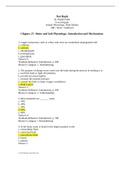
-
Test Bank by Joseph Esdin to accompany Animal Physiology, Third Edition Hill • Wyse • Anderson
- Exam (elaborations) • 20 pages • 2022
-
- $9.49
- + learn more
Chapter 27: Water and Salt Physiology: Introduction and Mechanisms 1. Larger crustaceans, such as a blue crab, have an exoskeleton impregnated with a. cellulose. b. calcium. c. phospholipids. d. proteoglycans. e. glycolipids. Answer: b Textbook Reference: Introduction, p. 699 Bloom’s Category: 1. Remembering 2. The purpose of taking excess water into the body during the process of molting is to a. swell the body to fight off predators. b. provide structural rigidity. c. increase t...
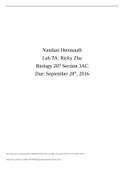
-
SCIENCE 207 Nandani Hemnauth Bio 207 final intro
- Exam (elaborations) • 4 pages • 2022
-
- $8.49
- + learn more
Introduction Red blood cells (erythrocytes) are the most common type of blood cells and the vertebrate’s primary means of delivering oxygen to the cells of the body through the blood. The cells are composed of hemoglobin, a molecule that binds to oxygen and also carries some of the carbon dioxide produced in the tissue back to the lungs. The red color of erythrocytes is also the result of hemoglobin, which consists of iron and protein; increase or decrease in the concentration of hemoglo...
AnPhys3e Ch29 Test Bank. Questions with correct answers
AnPhys3e Ch27 Test Bank
AnPhys3e Ch28 Test Bank

Study stress? For sellers on Stuvia, these are actually golden times. KA-CHING! Earn from your study resources too and start uploading now. Discover all about earning on Stuvia



